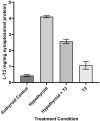Nongenomic roles of thyroid hormones and their derivatives in adult brain: are these compounds putative neurotransmitters?
- PMID: 37701902
- PMCID: PMC10494427
- DOI: 10.3389/fendo.2023.1210540
Nongenomic roles of thyroid hormones and their derivatives in adult brain: are these compounds putative neurotransmitters?
Abstract
We review the evidence regarding the nongenomic (or non-canonical) actions of thyroid hormones (thyronines) and their derivatives (including thyronamines and thyroacetic acids) in the adult brain. The paper seeks to evaluate these compounds for consideration as candidate neurotransmitters. Neurotransmitters are defined by their (a) presence in the neural tissue, (b) release from neural tissue or cell, (c) binding to high-affinity and saturable recognition sites, (d) triggering of a specific effector mechanism and (e) inactivation mechanism. Thyronines and thyronamines are concentrated in brain tissue and show distinctive patterns of distribution within the brain. Nerve terminals accumulate a large amount of thyroid hormones in mature brain, suggesting a synaptic function. However, surprisingly little is known about the potential release of thyroid hormones at synapses. There are specific binding sites for thyroid hormones in nerve-terminal fractions (synaptosomes). A notable cell-membrane binding site for thyroid hormones is integrin αvβ3. Furthermore, thyronines bind specifically to other defined neurotransmitter receptors, including GABAergic, catecholaminergic, glutamatergic, serotonergic and cholinergic systems. Here, the thyronines tend to bind to sites other than the primary sites and have allosteric effects. Thyronamines also bind to specific membrane receptors, including the trace amine associated receptors (TAARs), especially TAAR1. The thyronines and thyronamines activate specific effector mechanisms that are short in latency and often occur in subcellular fractions lacking nuclei, suggesting nongenomic actions. Some of the effector mechanisms for thyronines include effects on protein phosphorylation, Na+/K+ ATPase, and behavioral measures such as sleep regulation and measures of memory retention. Thyronamines promptly regulate body temperature. Lastly, there are numerous inactivation mechanisms for the hormones, including decarboxylation, deiodination, oxidative deamination, glucuronidation, sulfation and acetylation. Therefore, at the current state of the research field, thyroid hormones and their derivatives satisfy most, but not all, of the criteria for definition as neurotransmitters.
Keywords: iodothyronine; neurotransmitter; non-canonical; nongenomic; thyroacetic acid; thyronamine; thyroxine.
Copyright © 2023 Martin and Sarkar.
Conflict of interest statement
The authors declare that the research was conducted in the absence of any commercial or financial relationships that could be construed as a potential conflict of interest.
Figures




Similar articles
-
Thyroid Hormones and Derivatives: Endogenous Thyroid Hormones and Their Targets.Methods Mol Biol. 2018;1801:85-104. doi: 10.1007/978-1-4939-7902-8_9. Methods Mol Biol. 2018. PMID: 29892819 Review.
-
Unveiling the nongenomic actions of thyroid hormones in adult mammalian brain: The legacy of Mary B. Dratman.Front Endocrinol (Lausanne). 2023 Sep 29;14:1240265. doi: 10.3389/fendo.2023.1240265. eCollection 2023. Front Endocrinol (Lausanne). 2023. PMID: 37842308 Free PMC article. Review.
-
Alternate pathways of thyroid hormone metabolism.Thyroid. 2005 Aug;15(8):943-58. doi: 10.1089/thy.2005.15.943. Thyroid. 2005. PMID: 16131336 Review.
-
Thyronamines are substrates for human liver sulfotransferases.Endocrinology. 2007 Apr;148(4):1921-7. doi: 10.1210/en.2006-1172. Epub 2007 Jan 4. Endocrinology. 2007. PMID: 17204552
-
Thyronamines and Analogues - The Route from Rediscovery to Translational Research on Thyronergic Amines.Mol Cell Endocrinol. 2017 Dec 15;458:149-155. doi: 10.1016/j.mce.2017.01.002. Epub 2017 Jan 6. Mol Cell Endocrinol. 2017. PMID: 28069535 Review.
Cited by
-
Thyroid hormone levels in patients with bipolar disorder: a systematic review and meta-analysis.BMC Endocr Disord. 2024 Nov 18;24(1):248. doi: 10.1186/s12902-024-01776-1. BMC Endocr Disord. 2024. PMID: 39551764 Free PMC article.
-
Could thyrotropin serum level characterize major depressive disorder phenotype? A systematic review and meta-analysis.J Endocrinol Invest. 2025 Aug 19. doi: 10.1007/s40618-025-02687-1. Online ahead of print. J Endocrinol Invest. 2025. PMID: 40828484 Review.
References
-
- Laurberg P. Hypothyroidism. In: Greer MA, editor. The Thyroid Gland. New York: Raven Press; (1990). 497–535.
-
- Emerson CH, Liberman C, Braverman LE. Hypothyroidism. In: Green WL, editor. The Thyroid. New York: Elsevier; (1987). 219–70.
-
- Orgiazzi JJ, Mornex R. Hyperthyroidism. In: Greer MA, editor. The Thyroid Gland. New York: Raven Press; (1990). 405–95.
-
- Utiger RD. Hyperthyroidism. In: Green WL, editor. The Thyroid. New York: Elsevier; (1987). 157–218.
Publication types
MeSH terms
Substances
LinkOut - more resources
Full Text Sources

